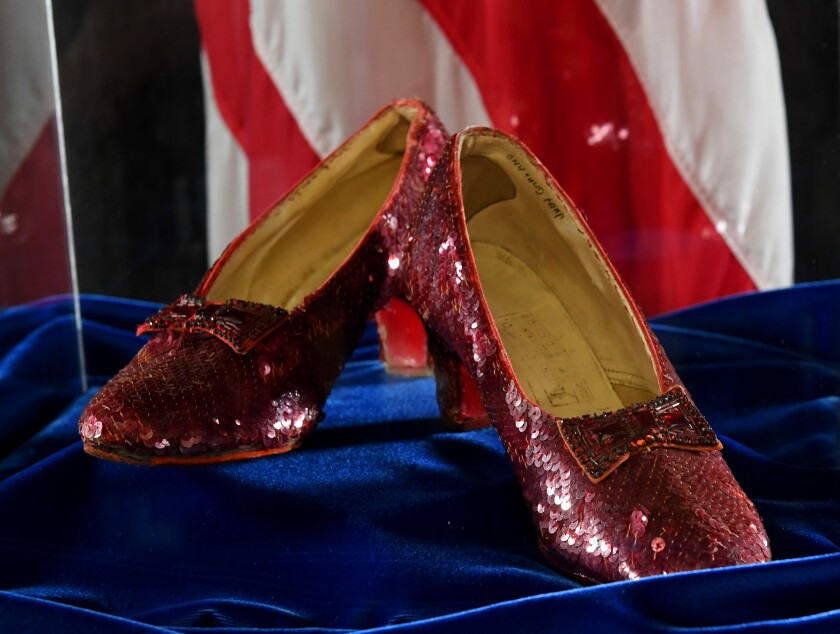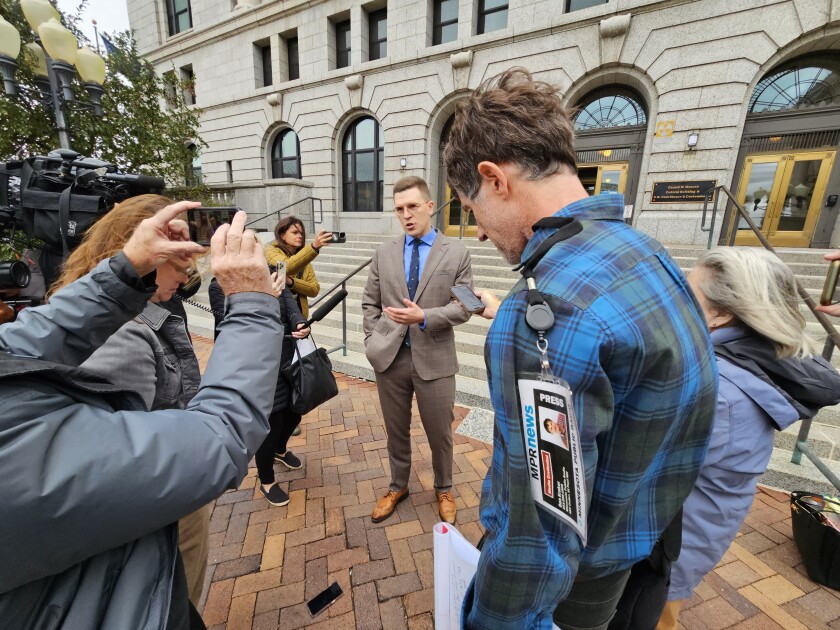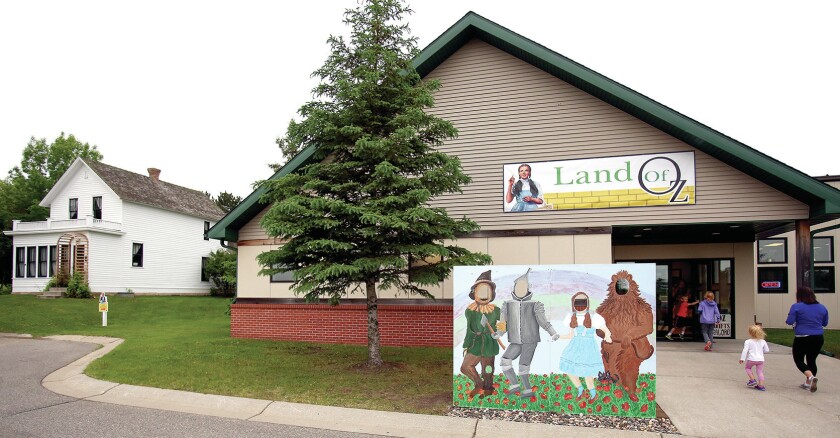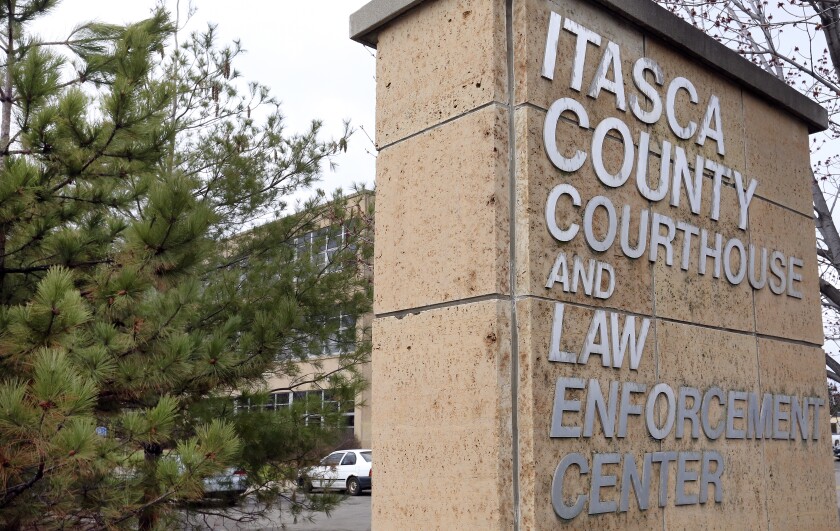DULUTH — A rural Grand Rapids man testified Friday that he stole a famed pair of ruby slippers from the Judy Garland Museum nearly two decades ago because he believed they contained valuable gems.
“I had a jewelry fence,” Terry Jon Martin said, referring to a person who trades in stolen goods. “I took them to the fence and he showed me that they were glass. Instead of rubies, they were glass. So I didn’t want anything else to do with them.”
ADVERTISEMENT

Martin, 76, appeared in U.S. District Court in Duluth to plead guilty to a count of theft of major artwork, providing for the first time a public admission that at least partially unravels the long-running mystery behind one of the region’s most notorious crimes.
Martin, using a wheelchair and carrying an oxygen tank, has advanced COPD and is receiving hospice care, said defense attorney Dane DeKrey. Wearing a flannel shirt and N95 mask, he did not speak to reporters before or after the hearing, though he was able to clearly answer questions in court.
Federal prosecutors, citing Martin’s “extreme infirmity,” indicated they would not recommend any prison time in the case.
Chief Judge Patrick Schiltz ordered a background investigation and said he hopes to schedule a sentencing date in Duluth within the next three months.
Martin, indicted by a grand jury in May, acknowledged that he used a small sledge hammer to break into the Grand Rapids museum in August 2005, shattering first a glass door and then the Plexiglas case that protected the pair of slippers used in the filming of the 1939 classic, “The Wizard of Oz.”

He said he briefly stored the artifacts in a trailer near his home, about 12 miles south of the museum, before giving them to the fence. He did not name that person and said he played no role in a later attempt to extort an insurance company.
The slippers, which had been on loan to the museum from a Hollywood collector, were ultimately recovered by the FBI and Grand Rapids Police Department in Minneapolis in July 2018.
ADVERTISEMENT
DeKrey said his client “has lived a fast and loose life, and I think he’s OK with what’s happening now.”
“I believe he’s at peace with what’s about to happen in his life,” the defense attorney said after the hearing. “This sounds funny, but I don’t think this is a particularly important thing in terms of his life.
“Not because the ruby slippers don’t deserve that. It’s because when you face your own mortality, very few things matter other than wanting to get your affairs in order and saying the things you need to say to the people you need to say them to, and I don’t think this is one of them. I think this is 2005 Terry, not 2023 Terry.”
John Kelsch, the museum’s founding executive director and now curator, was the first person to discover the shattered glass the next morning. He said he was happy to receive at least some measure of closure from Friday’s plea, though he was left scratching his head at Martin’s explanation.
“To do it because he thought that they were real rubies, and to turn them over to a jewelry fence — I mean, the value is not rubies,” Kelsch said. “The value is an American treasure. A national treasure. To steal them without knowing that seems ludicrous.”
The slippers are one of four surviving pairs worn by Garland, a Grand Rapids native, in the filming of one of the most famous films of all time. They were insured at the time for $1 million, but federal agents said they are currently appraised at more than $3.5 million.

The slippers were nearing the end of a 10-week loan to the birthplace museum when they were stolen sometime overnight Aug. 27-28, 2005. Shattered glass and a red sequin were all that were left after an emergency exit door window was broken and the slippers' glass case was broken. It was later discovered that the museum's alarm system hadn't been set properly to notify a private security firm.
ADVERTISEMENT
The brazen theft continued to captivate Garland's hometown, the state and the arts community for 13 years. The police department received tips from around the world, a dive team searched Tioga Mine Pit in 2015 and an anonymous fan offered a $1 million reward for information leading to the slippers' recovery.
While Grand Rapids police long tinkered with the investigation, the FBI said it became involved in 2017 when an extortion attempt was made against the insurance company that now owns the slippers.
The agency's Minneapolis division and Art Crime Team executed search warrants in both Minnesota and Florida and recovered the slippers in the Minneapolis "sting operation" — though authorities have since remained tight-lipped about that component of the case.
The FBI said the recovered slippers were sent to the Smithsonian's National Museum of American History in Washington, D.C., where conservators confirmed their authenticity after an extensive examination of the slippers' construction, materials and wear.
Michael Shaw, a Los Angeles collector and acting coach, owned the slippers at the time of the theft. However, he later accepted an $880,000 payout from his insurer, the Markel Corp.
In entering the plea, Martin was asked to acknowledge that the slippers were an “object of cultural heritage,” that they were taken from a museum and that they are worth at least $100,000.
“I believe they are worth quite a bit more,” he told Judge Schiltz.
ADVERTISEMENT
The theft charge carries a maximum of 10 years in prison, though Assistant U.S. Attorney Matthew Greenley said he would not argue for any incarceration and believed any supervision should be minimal due to Martin’s health. DeKrey said there is no further cooperation component of the agreement, with Martin fulfilling his duty by truthfully testifying in court Friday.
Schiltz is not technically bound by the recommendations, but judges don’t often depart from a stipulated sentencing agreement.
The prosecution has been handled by federal prosecutors in North Dakota for reasons that have not been disclosed. DeKrey, who practices in the Fargo-Moorhead area, indicated he also was asked to take the case due to a conflict in the federal public defender’s office.
DeKrey underscored the severity of his client’s health concerns, saying he is “basically slowly suffocating to death” and has significant difficulties breathing as a result of simple tasks like getting a cup of coffee.
“I don't know what to expect with where we will be month by month,” he said. “Even with an expedited schedule, with his condition, I’m not sure if we’re going to get to a sentencing date.”
This story was updated at 1:50 p.m. Oct. 13 with additional details and comments from the hearing. It was originally posted at 11:38 a.m. Oct. 13.



















